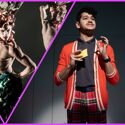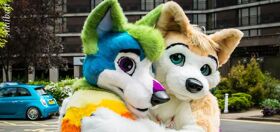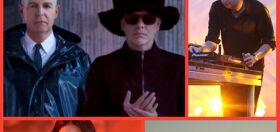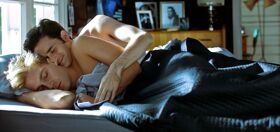
Here’s another look at dandyism, the more affable younger brother of narcissism.
Those boys with one eye on the mirror and the other on you play a large role in the work of American painter, Ryan Greene, whose 40 x 50” oil paintings illustrate the unspoken “decisive ambiguity” of the movement itself while also examining class issues.
In an email interview from Tunis – where he says the art scene “is limited to me teaching bored ambassador’s wives to pain, and schlocky paintings of camels and palm trees” – Greene proves that, contrary to popular belief, not all artists are narcissists.
Queerty: So, the best place is to start is the beginning. Where are you from?
Ryan Greene: I was born in upstate New York: college town, lots of trees and rivers, fairly middle of nowhere.
How about we take this to the next level?
Our newsletter is like a refreshing cocktail (or mocktail) of LGBTQ+ entertainment and pop culture, served up with a side of eye-candy.

Queerty: Growing up, did you always want to be an artist, or were there some other dreams along the way?
RG: Definitely wanted to be a chef. I still make good pancakes and I think soup. Someone back me up here.
Queerty: What is it about creating art that you find so alluring?
RG: I guess just that, the act of creating something, figuring things out. I think perhaps I need to mention that I started painting when I was like 11 and had no friends.
Queerty: What do you strive for in your work?

RG: I don’t actually ever figure anything out by painting something. I really don’t want to tell anyone else what their response should be. I like to play with kitsch images, but I don’t like being ironic. This leaves the paintings in a state that is a little bit uncomfortable and conflicted. I will admit that I don’t always like the paintings, but they are still the paintings I want to make. Not sure if that answers you.
Queerty: What is it about class and dandyism that attracts you?
RG: Class issues are unavoidable when talking about dandyism. Normally we would be surprised by the idea of working-class dandies. But if we look at dandyism out of its social context, or any context, it is essentially a cult of aestheticism: a life devoted to being pretty, and being surrounded by pretty things. There is an inherent conflict there that is interesting to me. Also, of course, all of this prettiness plays into sexuality, gender, identity, etc.
Queerty: Let’s talk about class for a second: it seems that most of society yearns for more so-called class, yet the chasm between rich and poor continues to grow. What effect does this have on your portrayal of class, if any?
RG: The concept of class is escapable. In the US, the belief in class mobility is obviously a major part of the national psyche. Nonetheless it’s true that the rich are rich like never before, and the not-so- rich really haven’t gotten anywhere. It makes my portrayal of class a little more uncomfortable, but maybe also more attractive, because after all most of us are still striving, even if we pretend we aren’t.
Queerty: You’re obviously an exceedingly talented artist, but we all have something about ourselves that we’d like to change. What’s yours?
RG: (I feel like I should’ve answered this question just so you would include the blatant flattery.)
Queerty: To what end do you strive? Is there an end in sight?
RG: None, nope. At least, I hope not any time soon.

[Editor’s Note: Take a look at Ryan Greene’s work and you’ll see flattery plays no part.]
Images:
Ryan Greene, “3 Team Players” [Installation View] 2005 Oil on masonite
Ryan Greene, “Cake Party,” 2005 Oil on canvas
Ryan Greene, “For Pussies,” 2005 Oil on canvas
Ryan Greene, “14-12,” 2005 Oil on canvas




















tom O'Gorman
sorry. I really do not want to appear a smarty pants, but this painting is not by Michelangelo, but rather Caravaggio ( neee Michelangelo Merisi). It is a wonderful painting that hangs in Rome in th ePalazzo Barbarini. Michelangelo (of Sistine Ceiling fame) lived a century earlier. Caravaggio, you know, love the boys. tog